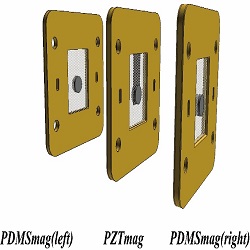
Po-Ching Hsu
National Taiwan University, Taiwan
Title: Magnetically driven piezoelectric proton exchange membrane fuel cell stack with built-in manifold
Biography
Biography: Po-Ching Hsu
Abstract
In this study, a magnetically driven piezoelectric proton exchange membrane fuel cell stack with built-in manifold is developed. To optimize the piezoelectric actuator (PZT actuator), several PDMS diaphragms with different Young’s moduli are fabricated and integrated with the PZT operating under voltage and frequency ranges of 10–50 V and 15–300 Hz, respectively. The effect of the sizes of magnets used (with the PZT actuator) on the performance of the PZTmag and the PDMSmag is investigated. On the other hand, to simplify the hydrogen pipeline and reduce the total volume and weight of the fuel cell stack, manifolds are developed to uniformly provide hydrogen to each cell using only one pipeline. As a result, the PZT actuator (with a curing time of 30 min for the PDMS) produces the largest amplitude of 1602 μm under the resonance frequency of 135 Hz and voltage of 40 V. The power consumption is 0.073 W. This optimized PZT actuator is used in the air breathing pumps of the magnetically driven PEMFC stack. When both the PZTmag and the PDMSmag use magnets 6 mm in diameter, a maximum amplitude of 87 μm is produced under operating conditions of 70 Hz and 40 V, which can provide sufficient air to the stack. The power consumption is 0.03 W.

Figure 1: The Schematic of the air breathing pump components of magnetically driven PEMFC stack
Recent Publications:
1. D. Fuard, T. Tzvetkova-Chevolleau, S. Decossas, P. Tracqui, P. Schiavone (2008) Optimization of poly-di-methyl-siloxane (PDMS) substrates for studying cellular adhesion and motility. Microelectronic Engineering 85:1289-1293.
2. A. Ullmann (1998) The piezoelectric valve-less pump—performance enhancement analysis. Sens. Actuators A: Phys. 69:97-105.
3. H.K. Ma, S.H. Huang, B.R. Chen, L.W. Cheng, J (2008) Numerical study of a novel micro-diaphragm flow channel with piezoelectric device for proton exchange membrane fuel cells. Power Sources 180:402-409.
4. H.K. Ma, J.S. Wang, Y.T. Chang, J (2011) Development of a novel pseudo bipolar piezoelectric proton exchange membrane fuel cell with nozzle and diffuser. Power Sources 196:3766-3772.
5. H.K. Ma, H.M. Cheng, W.Y. Cheng, F.M. Fang, W.F. Luo, J (2013) Development of a piezoelectric proton exchange membrane fuel cell stack (PZT-Stack). Power Sources 240:314-322.

